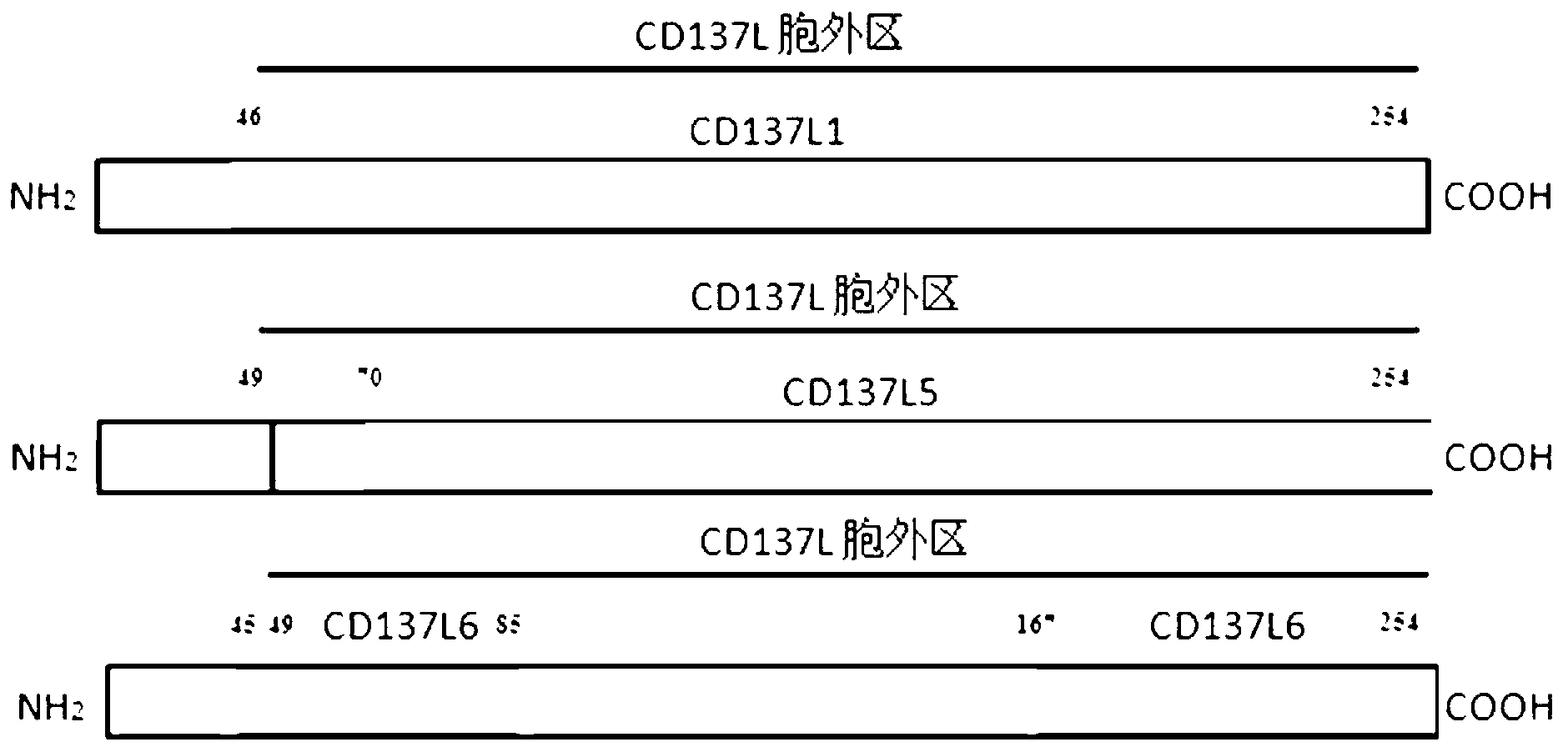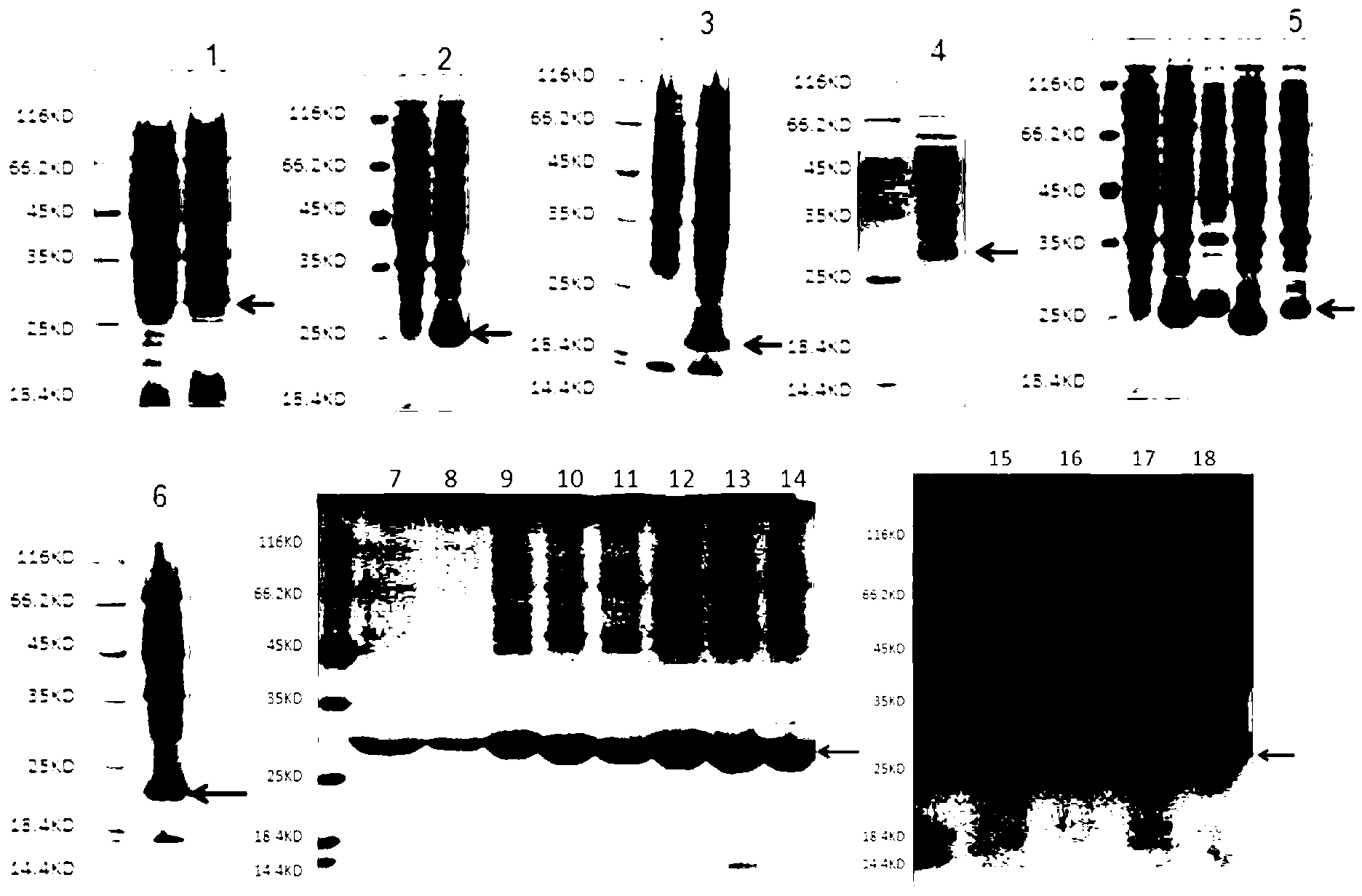Fusion protein with double functions of inhibiting revascularization of tumor microenvironment and activating adaptive immune response, and gene and application thereof
A dual-function, gene technology, applied in the field of bioengineering, can solve the problem of not changing the function of T cells
- Summary
- Abstract
- Description
- Claims
- Application Information
AI Technical Summary
Problems solved by technology
Method used
Image
Examples
Embodiment 1
[0070] Example 1: Expression of recombinant protein Tumstatin-CD137L with Tumstatin activity and CD137L activity in E. coli expression system
[0071] 1. Construction of expression system
[0072] A total of 18 bifunctional recombinant proteins with Tumstatin activity and CD137L activity were designed, which were fusions of Tumstatin1 / Tumstatin2 / Tumstatin3 / Tumstatin7 and CD137L1 / CD137L5 / CD137L6 with connecting peptides ( figure 1 ). Among them, CD137L1, CD137L5, and CD137L6 are respectively from amino acids 46-254, 83-254, 45-85, and 167-254 of the full-length amino acid sequence of CD137L ( figure 2 ). The nucleotide sequence of the protein is the sequence shown in SEQ ID NO.1 to SEQ ID NO.18, the amino acid sequence encoded by translation is the sequence shown in SEQ ID NO.19 to SEQ ID NO.36, and the connecting peptide is selected from SEQ ID NO. 56 to one of the sequences shown in SEQ ID NO.63.
[0073] The nucleus encoding the amino acid sequence of CD137L extracellul...
Embodiment 2
[0135] Example 2: Expression of recombinant protein Tumstatin-CD137L with Tumstatin activity and CD137L activity in Bacillus subtilis expression system
[0136] 1. Construction of expression system
[0137] Using the pBluescriptII SK(+) vector constructed in Example 1 containing the complete recombinant protein gene sequence (SEQ ID NO.1-18) as a template, by designing different primers (5'PstI, 3'HindIII) and performing PCR, Amplify the different fusion protein genes connected to the pBluescriptII SK(+) vector and connect the complete fragment to the expression vector pP43 (the vector needs to be digested with PstI and HindIII before the ligation experiment). The operation steps such as PCR and enzyme digestion and connection are the same as the construction part of the fusion protein gene in Example 1. After the expression vector was constructed, the electroporation operation was carried out (for details, please refer to the instructions of the Bio-Rad electroporation instr...
Embodiment 3
[0142] Example 3: Expression of recombinant protein Tumstatin-CD137L with Tumstatin activity and CD137L activity in yeast expression system
[0143] 1. Construction of expression system
[0144] The different fusion protein genes (SEQ ID NO.1-18) integrated in the pBluescriptII SK(+) vector were digested with EcoRI and NotI and ligated into pPIC9K to complete the vector construction. Subsequently, the electroporation operation was carried out (see the instruction manual of the Bio-Rad electroporation instrument for details), and the construction of the recombinant strain of Pichia pastoris GS115 was completed.
[0145] Expression of recombinant protein
[0146] Using BMGY enrichment bacteria, BMMY induced expression strategy to ferment to obtain the target product. On the first day, the expression strain constructed according to the above method was inoculated into the YPD seed medium, and cultivated overnight at 37°C. The next day, transfer an appropriate amount of seed cu...
PUM
 Login to View More
Login to View More Abstract
Description
Claims
Application Information
 Login to View More
Login to View More - R&D
- Intellectual Property
- Life Sciences
- Materials
- Tech Scout
- Unparalleled Data Quality
- Higher Quality Content
- 60% Fewer Hallucinations
Browse by: Latest US Patents, China's latest patents, Technical Efficacy Thesaurus, Application Domain, Technology Topic, Popular Technical Reports.
© 2025 PatSnap. All rights reserved.Legal|Privacy policy|Modern Slavery Act Transparency Statement|Sitemap|About US| Contact US: help@patsnap.com



